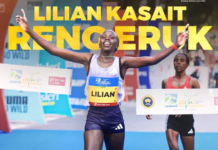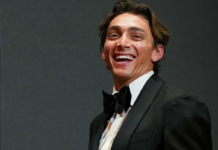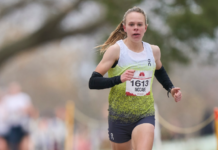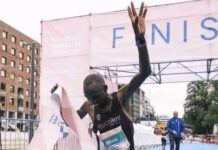© Copyright – 2025 – Athletics Illustrated
The last of the Russian dopers discovered during the exhaustive, 10-year investigation of the Moscow-based Laboratory Information Management System (LIMS) has been named.
The Athletics Integrity Unit, established by the World Anti-Doping Agency (WADA) in 2017 as part of athletics’ response to the doping crisis, said it was the “last batch” of doping cases.

That evidence, along with findings from WADA investigator Richard McLaren, “exposed the state-sponsored Russian doping scandal,” the AIU said in a post on X (Twitter). The Russian government has consistently denied wrongdoing.
The athletes
| Name | Event | Note |
| Elena Kotulskaya | 800m | 2013 Euro champs – silver |
| Marina Novikova Pandakova | Racewalker | 2013 Euro champs – silver |
| Marat Ablyazov | Sprinter | 10.36 PB |
| Pavel Ivashko | 400m | 2015 U23 Euro – silver |
| Inessa Gusarova | 800m | 2023 Russian Champion |
| Svetlana Rogozina | Middle-distances | 2014 Russian Champion |
| Veronika Chervinskaya | Hurdles | 13.03 PB |
| Margarita Smirnova Korneychuk | Heptathlon | 1994 4547pts PB |
| Natalya Kholodilina | Racewalker | Already banned since 2014 |
| Tatyana Dektyareva Dementyeva | 100m hurdles | Three time national champ |
| Valeriya Fyodorova | Triple jump | World U20 finalist |
| Svetlana Karamasheva | Middle-distances | Three-time national champ |
There doesn’t seem to be an end to the Russian doping crisis
In December 2021, RusAF narrowly avoided being permanently banned from sport. The organization failed to pay several million dollars in fines for delaying a special WADA committee from getting access to the LIMS mainframe computer, central to the systematic doping.
By mid-2020, the investigation of 61 suspect doping samples had been documented. Allegedly, many more have been since.
By April 2021, WADA had completed 298 tests of Russian athletes.
In June 2020, Yevgeny Yurchenko resigned as President of RusAF after serving just six months in the position. The reason? RusAF failed to pay a $6-million-dollar fine (of $10-million USD) owed to World Athletics.
The fine was levied in place of being expelled altogether from World Athletics due to a long trail of corruption to do with alleged extortion, bribery, drug cover-up, and data manipulation, to name a few illegal activities that Russia is accused of.
“I hope that the newly elected head of the All-Russian Athletics Federation will be able to move forward in resolving almost five-year difficulties in relations with World Athletics, and will also ensure that sufficient funding is raised for the development of the Federation,” he said.
IN 2020, Russian athletes who were likely to compete internationally under a neutral flag had written an open letter to Russian President Vladimir Putin. They asked him to intervene in the issue, to no avail.
Later in the year, world champion high jumper Danil Lysenko was up against the possibility of receiving an eight-year ban. This came after Russian officials apparently obstructed an investigation into the world indoor high jump champion.
Russian Anti-Doping Agency’s Yury Ganus told TASS at the time and the Russian news agency that “all steps taken by the previous executive management at the RusAF led to the fact that he would continue performing as an athlete only after eight years.”
In early June 2020, Alexander Shustov received a four-year ban from the Athletics Integrity Unit, which the CAS upheld after testing positive for a banned substance.
There have been a few more suspensions since.
And then there are the storytellers
Internal bloodletting continued, where chaos and infighting were killing any remaining civility.
Grigory Rodchenkov published his tell-all book, The Rodchenkov Affair: How I brought Down Putin’s Secret Doping Engine.
He didn’t pull any punches.
At the same time, Russian whistleblower Vitaly Stepanov and his athlete wife Yulia Rusanova were the subject of another tell-all biographical account of life in Russian sport.
Icarus, is a documentary by amateur American cyclist Bryan Fogel, from the first-person perspective, with his plan to dope and beat the system. The film documents just how easy it is for professional athletes to get away with it. But the “stuff” gets real partway through, and the documentary takes a sharp left turn into indomitable chaos.
The Russian Affair, according to author David Walsh, is a love story. It is, however, The Russian Affair love story is set against the backdrop of the world’s greatest ever scandal in sport; uninhibited doping and corruption that rots Russian sport to the core.
It was about a third of the way in, where we are enjoying a Michael Moore-ish or perhaps Super Size Me type yawner that Rodchenkov gets caught in the middle of the Great Russian doping scandal of modern sporting history – bigger than Ma Junren of China, bigger than Lance, bigger than BALCO.
Much of this began with German broadcaster ARD/TV led by investigative journalist Hajo Seppelt, who cracked the lid on Russian and Kenyan doping. They also delved deeply into the International Association of Athletics Federations’ issues with former President Lamine Diack and his son Papa Massata Diack.
If WADA, CAS, World Athletics, and the International Olympic Committee thought that Russian doping is anywhere near over, they had their heads buried deep in a Moscow snowdrift. This end to the Russian doping drama closes that chapter, which does not mean that systematic doping has ended.














